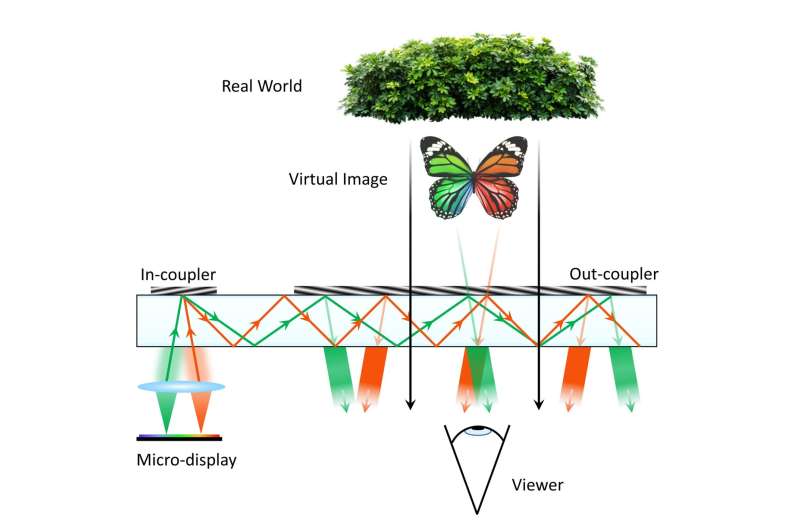This article has been reviewed according to Science X's editorial process and policies. Editors have highlighted the following attributes while ensuring the content's credibility:
fact-checked
peer-reviewed publication
trusted source
proofread
Exploring advances in waveguide-based augmented reality displays

In recent decades, augmented reality (AR) has evolved from a futuristic concept to a tangible and pervasive technology. AR enhances our perception and interaction with the environment by seamlessly blending projected virtual content with real-world scenes. Waveguide-based AR displays have emerged and developed as a critical technology for wearable AR systems, enabling them to be lightweight and have a slim form factor while keeping high optical performance.
Waveguide combiners are critical components of waveguide-based AR displays. They function as light guides to fold the optical path and replicate luminosity from a small light source across an expansive area. This is achieved through a process called exit pupil expansion (EPE), which mirrors the process of replicating a single incoming beam into numerous beams, each with an equal intensity.
In a new paper published in eLight, a team of scientists led by Professor Shin-Tson Wu from the University of Central Florida and Professor Haowen Liang from Sun Yat-sen University have reviewed the development of waveguide combiners for augmented reality displays.
There are distinct types of waveguide combiners, each with its own advantages and disadvantages. The most common styles include geometric waveguide combiners, diffractive waveguide combiners, and holographic waveguide combiners.
Geometric waveguide combiners are the simplest type, but they can be bulky and have a limited field of view. Diffractive waveguide combiners are more complex to manufacture but can be thinner and have a wider field of view. Holographic waveguide combiners are the most advanced type and are expensive to manufacture.
Waveguide combiners are typically used with light engines to create waveguide-based AR displays. Light engines are the components that generate the light injected into the waveguide. Some of the most common types of microdisplay light engines include liquid-crystal-on-silicon, micro-LED, micro-OLED, laser beam scan, and MEMS.
Waveguide combiner design is a challenging task. Designers must consider a variety of factors, such as optical performance, manufacturability, and cost. Some key challenges in waveguide combiner design include EPE scheme design, the field of view expansion, front geometry design of couplers, full-color displays, optical efficiency, and uniformity optimization.
Waveguide combiner technology is still in its preliminary stages of development, but it has the potential to revolutionize AR displays. Designers are working to overcome the current challenges and develop new waveguide combiners that are more efficient, affordable, and easy to manufacture.
Geometric waveguide combiners offer a potentially large field of view (FoV), good uniformity, negligible eye glow, and high efficiency, but they have a more complicated fabrication process and low yield. Diffractive waveguide combiners have a relatively low efficiency and a smaller FoV, and they also suffer from other issues, such as color nonuniformity, eye glow, and rainbow effect.
Improving diffractive waveguide efficiency while maintaining good uniformity is a crucial challenge. Advancements in EPE designs, fabrication methods, and materials performance of diffractive couplers could enhance diffractive waveguide combiners to match geometric waveguide combiners.
However, the current refractive index modulation of VHGs (volume holographic gratings) is insufficient for extending the FoV beyond 50°, and low-cost, high-quality manufacturing processes for SRGs (surface relief gratings) are needed.
PVGs (polarization volume gratings), a novel diffractive coupler, provides dynamic modulation capabilities, expanding the functionality of waveguide-based AR displays.
Metasurface-based couplers offer extensive design freedoms, enabling novel functionalities like achromatic characteristics. Further advances in device engineering and manufacturing processes are expected to enhance the performance of PVGs and metasurface-based couplers for AR displays.
More information: Yuqian Ding et al, Waveguide-based augmented reality displays: perspectives and challenges, eLight (2023). DOI: 10.1186/s43593-023-00057-z
Journal information: eLight
Provided by Chinese Academy of Sciences



















